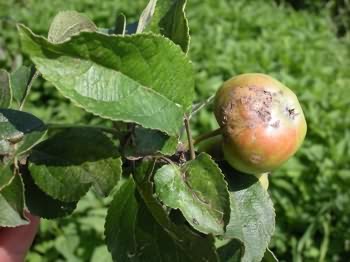Diseases
Venturia inaequalis G. Winter - Apple Scab
Systematic position.
Venturia inaequalis G. Winter (teleomorph) belongs to division Ascomycota, class Ascomycetes, order Dothideales, family Venturiaceae. Spilocaea pomi Fr.: Fr. (anamorph) belongs to division Deuteromycota, class Hyphomycetes, order Hyphomycetales, family Dematiaceae.Biological group.
Biotroph.Morphology and biology.
Apple Scab can be observed on leaves, petioles, blossoms, sepals, fruits, pedicels, and (less often) on young shoots and bud scales. First lesions are often found on the lower surface of leaves, as the latter emerge, being exposed to infection in spring. Young lesions are velvety brown to olive green, having indistinct feathery margins. Later the margins become distinct. As an infected leaf ages, the tissues adjacent to the lesion thicken, and the leaf surface becomes deformed. Ascospores are pale yellow, have one septum and it is 12-13 x 6 microns in size. Ascospores are the major source of primary inoculum, being produced within pseudothecia that develop in leaves during the winter months. The size of the pseudothecia is 60-160 microns. The first mature ascospores are capable of causing infections at about the time of bud break or soon thereafter. Young leaves remain susceptible for five to eight days, but their lower surfaces may become infected in late summer. The duration of the wet period required for infection increases with the age of the fruit, which remains susceptible until harvest. Conidia are olive, 20-30 microns long and 7-9 microns wide, pear-shaped, one- or two-cellular. Conidia of the fungus form on the surface of the lesion and become the source of secondary inoculum for the remainder of the season. Conidia are disseminated to developing leaves and fruit by splashing rain and wind. Several secondary cycles of conidial infection may occur during the growing season depending on the frequency of infection periods and the susceptibility of host tissue.Distribution.
The apple scab is found almost everywhere where apples grow. In areas with cold and wet springs the scab has the greatest significance. Development of epiphytic scabs (one time in 2 years, incidence is 50-100%) is defined by conditions of weather, i.e., by a combination of temperature and humidity. Most frequently, almost annually, the scab development is observed in areas of intensive fruit growing in the Northern Caucasus (Krasnodar and Stavropol Territories, Kabardino-Balkaria, Chechnya, Ingushetia, Alania), in the wettest areas of Transcaucasia, in the Transcarpathia, Ukrainian Polesye, and also in Moldova and Byelorussia, Baltic States and northwest regions of the Russian Federation. Areas with moderate Apple Scab development (one time in 3 years, incidence is 30-50%) are the central regions of the European part of the Russian Federation, forest-steppe of Ukraine, Azerbaijan, Georgia, some areas of Kyrgyzstan, Armenia and Crimea, the Volga Basin region, Altai Territory. Low disease severity (one time in 5 years, incidence is 15-30%) is observed in the steppe region of Ukraine and some areas of the Middle and Lower Volga Basin region, and in gardens of Crimea. Very low Apple Scab severity (one time in 8-10 years, incidence is 5%) is observed in the countries of Central Asia (except for Kyrgyzstan), in the South Ural and Trans-Ural regions, and in the Far East of Russia.Ecology.
Development of the Apple Scab is promoted by rainy weather and very warm sunny days. Abundant humidity is an obligatory condition for germination of spores. Optimum temperature for germination of ascospores is 12-16.C, max 25.C. Optimum temperature for germination of conidia is 22.C, max 27.C.Economic significance.
Apple Scab has a large economic importance, reducing size of fruits and quality of yield. The scab developing on fruits reduces the amount of vitamin C, and then, during storage, it promotes penetration of the agent of moniliosis into fruits, causing their decay. Control measures are various and include the use of resistant cultivars, sanitation of orchards, and chemical control.Reference citations:
Ablakatova A.A. 1965. Mycoflora and the main fungal diseases of fruit plants of the south of the Far East. Moscow-Leningrad: Nauka. 146 p. (In Russian)Fedorova R.N. 1971. Apple scab. Procedure of the local long-term forecast of diseases of plants. Leningrad: VIZR. 70-71 p. (In Russian)
Fedorova R.N. 1977. Apple scab. Leningrad: Kolos. 64 p. (In Russian)
Hawksworth D.L., Kirk P.M., Sutton B.C., Pegler D.N. 1995. Ainsworth & Bisby's Dictionary of the fungi. 8th edition. CAB International. 616 p.
James P.W., Hawksworth D.L. 1971. Ainsworth & Bisby.s dictionary of the fungi. 6th edition. CAB, Kew. 663 p.
Shumakova A.A. 1963. Apple scab. In: Polyakov I.Ya., Chumakov A.E., eds. Distribution of pests and diseases in agricultural crops in the USSR in 1962 and the forecast of their appearance in 1963. Leningrad: VIZR. 261-266 p. (In Russian)
© Bilder I.V.


